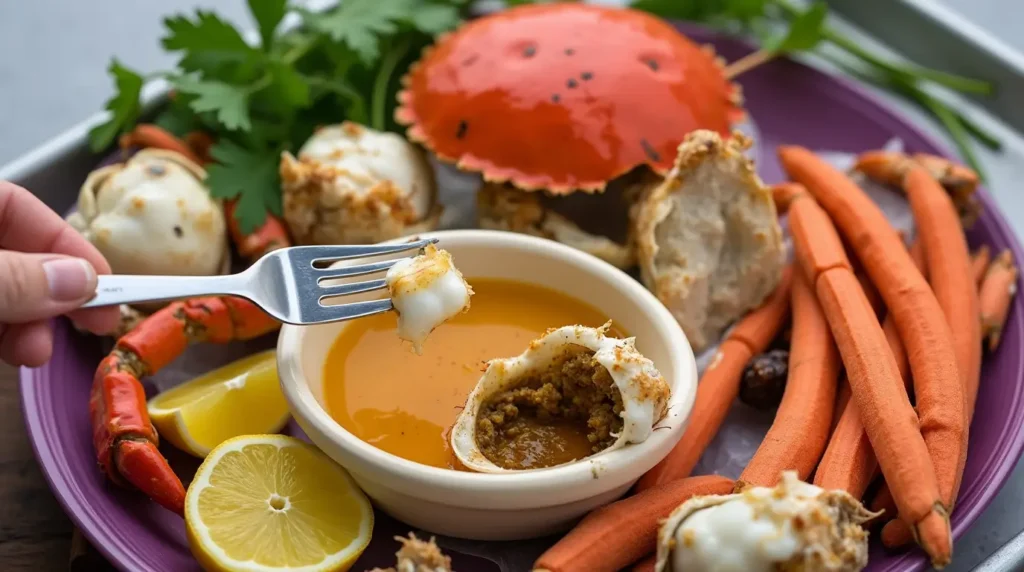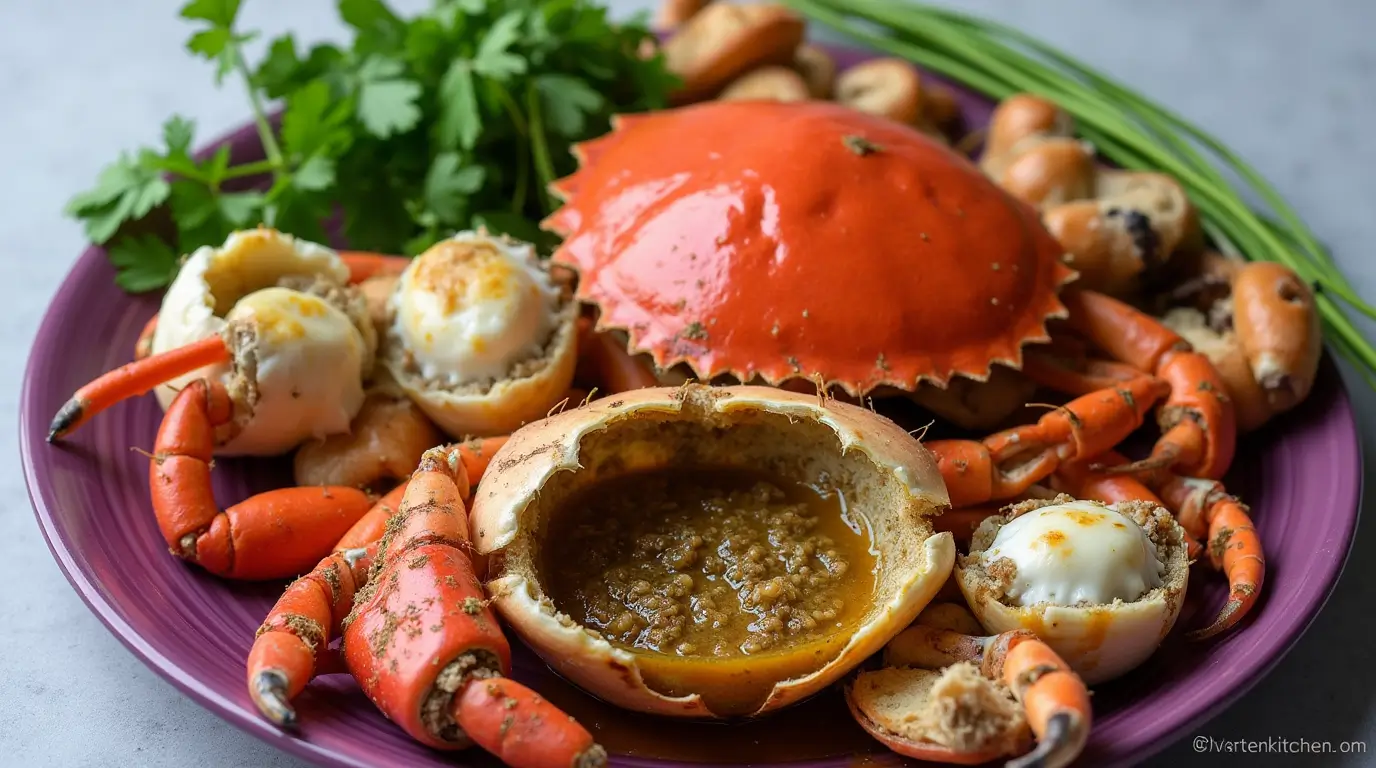There’s magic in a simple dish with the right sauce. Imagine grilling shrimp, steaming lobster, or topping veggies with homemade crab butter. It’s more than a condiment; it’s a way to make your dishes taste like they’re from a restaurant.
With four flavors—garlic, lemon, spicy, or plain—there’s something for everyone. And the best part? It’s ready in just 10 minutes. This means you can enjoy your meal more and cook less.
Crab butter is great for seafood lovers and busy cooks alike. It’s not just for crab legs. Try it on cornbread, in pasta, or as a dip. The possibilities are endless.
Table of Contents
Introduction to the Culinary Wonder of Crab Butter
Crab butter is more than just a condiment. It’s a flavor enhancer that makes seafood dishes gourmet. It mixes clarified butter with herbs, creating a smooth base that brings out the sweetness of crab meat. This sauce turns simple meals into unforgettable dining experiences.
What Makes Crab Butter a Gourmet Delight
The mix of butter and seafood is what makes it special. Chefs at Foraker Restaurant steam crab legs to keep them moist. They then add Old Bay or pickling spice to the butter, enhancing the flavor.
Alaska king crab is rich in protein and omega-3s, adding depth without being heavy. This makes each spoonful a burst of coastal taste.
The Rising Popularity of Homemade Seafood Condiments
Home cooks are making their own condiments to avoid preservatives. Shows like Deadliest Catch have highlighted Alaska king crab’s rarity, increasing its appeal. Making your own crab butter ensures quality and avoids imitations.
Choosing wild-caught Alaskan king crab supports sustainable fishing. It helps keep the oceans healthy by following strict catch limits.
Why Making Your Own Crab Butter Is Worth It
- Customization: Adjust herbs and spices to match your taste
- Cost savings: Making it at home costs less than $5 per serving, compared to $15+ at restaurants
- Freshness: Use fresh lemons and garlic to avoid preservatives
Steaming or boiling crab takes 10–15 minutes, allowing you to control the flavor. This method keeps the crab’s natural buttery texture while maintaining flavor quality. Homemade crab butter is a pantry staple that shows off your cooking skills.
What is Crab Butter and Why Seafood Lovers Treasure It
Crab butter sauce starts with clarified butter. This process removes milk solids, making it silky and preventing it from burning. It’s then mixed with garlic, lemon zest, and paprika.
This creates a glossy sauce that brings out the seafood’s natural sweetness. Seafood lovers adore it because it enhances the flavor without being too strong.
Its smooth texture is perfect for dipping crab legs or as a topping for pasta. Unlike thick sauces, it adds richness without overpowering. It’s a key ingredient in professional kitchens, making simple dishes taste like they’re from a restaurant.
- Customizable with herbs like dill or hot sauce for personal preferences
- Perfect for enhancing dishes like avocado crab toast or shrimp scampi
- Creates a velvety coating for fried crab cakes or bisque
Homemade crab butter lets you experiment with different flavors. You can add Old Bay for a Chesapeake Bay taste or parsley for a New England twist. It’s a canvas for creativity, all while celebrating the crab’s ocean flavor. Its silky texture and versatility make it a favorite among seafood enthusiasts.

Essential Ingredients for Perfect Homemade Crab Butter
Choosing the best ingredients is key to making great crab butter. These parts are the base of any how-to-make crab butter recipe. Let’s explore why each one is important for taste and texture.
Selecting the Right Type of Crab
Choose crab with distinct flavor profiles:
- Wild-caught Dungeness: Sweet and tender, ideal for mild sauces.
- Snow crab: Light and briny, perfect for subtle seafood notes.
- King crab: Bold and meaty, adds richness to butter bases.
Always use fresh or high-quality frozen crab meat for best results.
Quality Butter Selection Tips
Opt for unsalted European-style butter like Kerrygold, which contains 82% butterfat. This makes it creamier. Avoid margarine because it has too much water. Most recipes start with ¼ cup of butter.
Additional Ingredients for Enhanced Flavor
Customize your how-to-make crab butter by balancing these elements:
- Herbs: Fresh dill, parsley, or tarragon for brightness.
- Aromatics: Minced garlic or shallots add depth.
- Acidity: Lemon or lime juice balances saltiness.
- Spices: Cayenne, paprika, or Old Bay for heat or smokiness.
Combine these ingredients thoughtfully—too many strong flavors can overpower the crab’s natural sweetness.
The Basic Crab Butter Recipe – Your Foundation for All Variations
Learning the basic crab butter recipe begins with clarifying butter. This step makes a smooth, rich base for your dishes. Follow these steps carefully to avoid mistakes:
Step-by-Step Clarification Process
- Melt 1 cup of unsalted butter in a saucepan over medium heat.
- Bring to a gentle boil, then reduce heat to low and simmer for 3 minutes.
- Let the mixture cool and undisturbed for 10 minutes. This lets milk solids separate naturally.
- Skim the solids with a slotted spoon, then strain the golden liquid butterfat through a cheesecloth.
Pro tip: Use a fine mesh sieve for extra clarity. This crab butter recipe base works best when made 24 hours in advance for full flavor infusion.
Cooking Times and Temperature Control
- Boiling phase: 1 minute at medium-high
- Simmering phase: 3 minutes at low heat
- Cooling period: 10–15 minutes at room temperature
Keep the boiling point at 212°F for proper separation. Overheating can burn the butterfat, ruining the base.
Signs of Readiness
Perfect butter shows three key traits:
- Clear golden hue (no cloudy appearance)
- Settled milk residue at the bottom
- Subtle nutty aroma without burnt notes
Once ready, store in an airtight container for up to two weeks. This base is the foundation for your four flavor variations in section 6.

Nutrition Facts (per 1/4 cup serving)
- Calories: 180
- Protein: 35g
- Omega-3s: 0.6g
- Selenium: 6.5mg (59% DV)
Pair with crab legs or use as a dipping sauce—this base recipe adapts to any flavor profile you choose next.
Four Mouthwatering Crab Butter Flavors to Master
Start with the basic crab butter recipe and then try these four tasty variations. Each one adds something special to the base butter, making it perfect for seafood lovers.
- Plain Crab Butter: This classic mix uses clarified butter and a bit of salt. It’s great with grilled crab legs or as a topping for lobster. The simplicity lets the crab’s sweetness shine.
- Garlic Crab Butter: Add grated or roasted garlic for extra flavor. Fresh garlic has a strong taste, while roasted is milder. It’s perfect for dipping shrimp or as a sauce for crab-stuffed mushrooms. Adjust the garlic to your liking.
- Spicy Crab Butter: Add cayenne pepper, Tabasco, or red pepper flakes for heat. The butter’s creaminess balances out the spice. Start with ¼ teaspoon cayenne and add more if you like it spicier.
- Lemon Crab Butter: Mix in lemon zest and juice. The lemon brightens up dishes like crab linguine or grilled fish. Use both zest and juice for the best flavor.
Use plain versions with delicate fish like cod. Garlic is great for crab-stuffed shells. Spicy crab butter is perfect for shrimp tacos, and lemon is good with light salads. Keep leftovers in the fridge to keep the flavor fresh. Try these crab butter recipe variations to find the perfect match for your seafood.
Storage Tips and Shelf Life for Your Crab Butter Creations
Storing your homemade crab butter sauce correctly keeps it tasty and safe. Follow these tips to keep your sauce fresh. It’s perfect for seafood pasta or crab cakes.
Refrigeration Best Practices
Store your crab butter sauce in a sealed container or jar in the fridge. Make sure it’s at 40°F or below. This keeps it out of the “danger zone” (40–140°F). Use it within 5 days.
When you reheat it, do it gently. Use a saucepan over low heat or microwave in short bursts. This prevents it from separating.
Freezing Methods for Longer Preservation
To store it longer, freeze your crab butter sauce. Use containers or ice cube trays. Divide it into ¼-cup servings for easy use.
Wrap it tightly with foil or plastic wrap to avoid freezer burn. It can last up to 6 months this way. Thaw frozen portions in the fridge overnight before using.
Signs Your Crab Butter Has Gone Bad
If your crab butter sauce smells sour, is slimy, or is yellowish, throw it away. Trust your senses. If it smells fishy or separates too much, it’s not good anymore. Always check before serving.
Creative Ways to Use Your Homemade Crab Butter in Everyday Cooking
Use your crab butter in more than just boils. It can spice up your daily meals. Try it on roasted veggies like asparagus or sweet potatoes for a salty kick. Or you can mix it into mashed potatoes for a fancy touch.
- Mix into pasta dishes: Toss cooked fettuccine or linguine with warm crab butter. Then add steamed shrimp or grilled scallops.
- Seafood stuffing: Blend crab butter with breadcrumbs and herbs. Stuff salmon fillets before baking.
- Quick sauces: Simmer crab butter with white wine and lemon juice. Use it as a sauce for crab cakes or lobster tails.
- Savory breakfast: Spread on English muffins for crab butter avocado toast. Or melt into scrambled eggs for a rich start.
Pair spicy or garlic-infused crab butter with corn on the cob at summer barbecues. For rice, stir a spoonful into risotto or jasmine rice while cooking. Use it as a base for seafood boils by mixing with broth, garlic, and Cajun spices. It also makes hushpuppies better—add a tablespoon to the batter before frying.
With its versatility, crab butter becomes a must-have in your pantry. Try it on salads, in casseroles, or even as a popcorn topping at movie nights. Mix it with different flavors to match your dishes—smoky for grilled meats, lemon-dill for salads.
Common Mistakes to Avoid When Making Crab Butter Sauce
Making crab butter right means avoiding simple mistakes. These tips will help you steer clear of common errors:
Temperature Control Issues
- Never let butter brown—stop heating once melted to preserve its delicate flavor.
- Reheat crab butter slowly: Use low heat on the stove or 30-second microwave bursts to prevent separation.
- Cook crab meat to 145°F (63°C) to ensure safety without overcooking, which causes mushy textures.
Flavor Balance Problems
- Test seasoning gradually—too much salt or herbs can drown the crab’s natural sweetness.
- Add fresh garlic gently; over-sautéing creates bitterness. Aim for 1-2 minutes of light browning.
- Pair with high-quality butter to avoid greasiness. Unsalted butter gives better control over seasoning.
Texture Troubleshooting
- Stir crab meat gently into sauce to avoid breaking delicate lumps like jumbo lump crab.
- Avoid refrigerating warm sauce—store only after cooling to room temperature to prevent graininess.
- If separation occurs, whisk in a splash of cream or butter to re-emulsify.
By focusing on precision in heat, taste, and technique, your homemade crab butter becomes a versatile addition. It’s great for crab cakes or steamed shrimp. Remember, small changes can make a big difference in flavor.
Conclusion: Elevate Your Cooking with Homemade Crab Butter
Now that you know how to make crab butter, think of it as more than a crab butter dip. It’s a key ingredient that makes simple meals special. With just ½ lb of crab meat and ½ cup of butter, you can make a luxurious sauce for seafood.
Homemade crab butter is not just a sauce; it’s a healthier, tastier way to cook. It’s full of protein and omega-3s, fitting into today’s healthy eating trends. Chef Thomas Keller’s tips help you make it as good as a restaurant dish. Use it on toast, in pasta, or as a topping for grilled fish.
Enjoy your homemade crab butter dip with Sauvignon Blanc or Champagne for the best taste. Keep leftovers in the fridge for two days or freeze them for six months. Add cayenne or herbs to make it your own. Next time you cook seafood, let your crab butter be the highlight. Your taste buds and guests will love it. Make your kitchen better with this easy yet powerful recipe today.
FAQ
What is crab butter?
Crab butter is a tasty sauce made from clarified butter and crab essence. It’s rich and luxurious, perfect for seafood dishes.
How do I make homemade crab butter?
Begin by clarifying butter. Then, add the crab flavor using shells or meat. It’s important to control the temperature and consistency.
What are the different flavor variations of crab butter?
There are four main types: plain, garlic, lemon, and spicy crab butter. Each adds a unique taste to seafood dishes.
Can I use crab butter for dishes other than crab legs?
Yes, crab butter is versatile. Use it on grilled fish, in pasta, on veggies, or as a secret ingredient in seafood stuffings.
How should I store leftover crab butter?
Keep it in an airtight container in the fridge for up to 5 days. Freeze it in ice cube trays for up to 6 months.
What kind of crab should I use to make crab butter?
Dungeness, snow crab, and king crab are excellent choices. They each add unique flavors to your crab butter.
How do I prevent my crab butter from becoming grainy or separating?
Keep the temperature right while cooking. Don’t burn the butter. Reheat it gently to avoid separation.
What type of butter should I use for crab butter?
Choose high-quality European-style butter for the richest flavor. You can use salted or unsalted butter, depending on your taste.
How can I tell when my crab butter is ready to use?
It should be clear and golden, with a rich smell and smooth texture. This means it’s ready to use.
Did you sample our recipe?
There are no reviews yet. Be the first one to write one.

